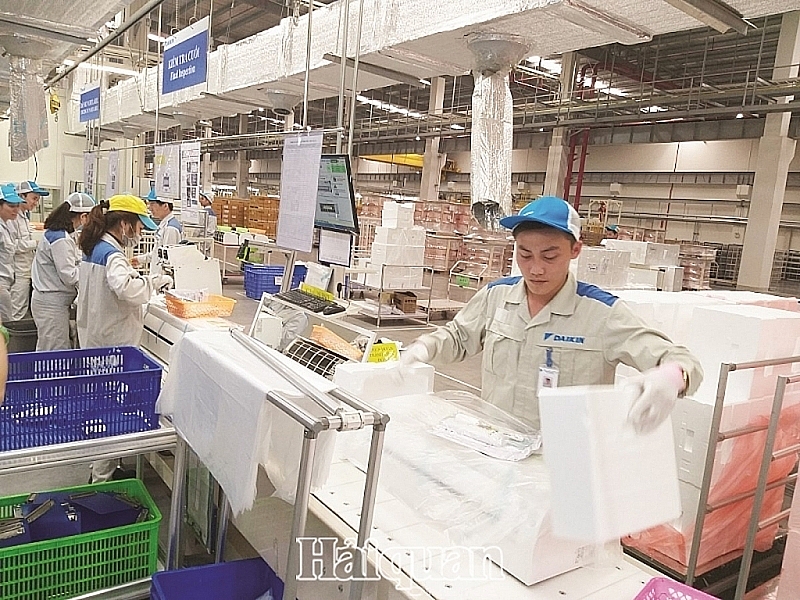Industrial production in the first quarter: many key industries fell
The industry's added value decreased by 0.82% over the same period last year, the deepest decrease in more than 10 years. Many important indicators of key industries declined, especially the processing and manufacturing industries.
 |
|
The index of industrial production declined due to "double" internal and external effects. Photo: Nguyen Thanh. |
The processing and manufacturing industry is no longer leading
According to the Ministry of Industry and Trade, in the first quarter of 2023, the added value of industry decreased by 0.82% over the same period last year, which is the deepest decrease of the same period of the years in the period 2011-2023, reducing 0.28 percentage points in the increase in total value added of the whole economy.
The main reason is due to the index plummet in some major industries. In particular, the processing and manufacturing industry was down 0.37%, leading to a drop of 0.1 percentage points to the overall growth of the economy; the mining industry decreased by 5.6% (coal mining output by 0.5% and crude oil production by 6%) equal to 0.2 percentage points; electricity production and distribution decreased by 0.32%, equivalent to 0.01 percentage points down.
Notably, in the first quarter, the processing and manufacturing industry no longer played the driving force for economic growth when the added value of the industry decreased by 0.37%, reducing 0.1 percentage points to the economy's overall growth.
Regarding the industrial production development index, right from the beginning of 2023, the economy's production capacity has shown signs of weakening, with a 14.6% decrease in the index of industrial production (IIP) month on month and down 8% year on year. In addition, the number of working days in January 2023 was less than in previous years as it coincided with the two New Year holidays.
Entering February 2023, the decrease in aggregate demand from abroad has resulted in the decline of orders and the size of orders, affecting industrial production.
In March, although industrial production recovered from the previous month when IIP increased by 9.6% compared to February 2023, there was a slight decrease over the same period (down 1.6%).
According to the Ministry of Industry and Trade, in the first quarter, the industrial production index decreased by 2.2% over the same period last year (6.8%). The processing and manufacturing industry decreased by 2.4%; electricity production and distribution decreased by 1%; the water supply industry, waste and wastewater management and treatment activities increased by 7.8%; the mining industry decreased by 4.5%.
Notably, the Q1 production index of the number of key industries in grade II decreased compared to last year. Specifically, the production of beds, cabinets, tables and chairs decreased by 13.5%; production of other means of transport decreased by 11.9%; paper production and paper products decreased by 10.3%; production of other non-metallic mineral products decreased by 8.7%; motor vehicle production decreased by 8.2%; production of costumes decreased by 7.7%; production of electrical equipment decreased by 6.9%.
A few industries increased, such as beverage production increased by 27.3%; production of coke and refined petroleum products increased by 19.4%; metal ore mining increased by 14%; production of rubber and plastic products increased by 11.6%; production of drugs, pharmaceutical chemicals and medicinal materials increased by 7.2%.
The report also noted that many key industrial products decreased in the first quarter of 2023. For example, automobiles decreased by 17.8%; bar steel and angle steel down by 15.8%; motorbikes down by 13.8%; phone components down by 13.4%; textiles from natural fibres and mobile phones together decreased by 13.1%; casual wear down 10.2%; cement decreased by 9.9%; urea fertilizer decreased by 6.3%; Gaseous natural gas decreased by 6.1%.
Notably, the consumption index of the whole processing and manufacturing industry decreased by 2.9% over the same period in 2022( by 6.6%). In particular, the inventory index of the entire processing and manufacturing industry was estimated as of March 31, 2023, up 4.4% over the same period last month and 19.8% over the same period last year (by 17.7%). As a result, the average inventory rate of the processing and manufacturing industry in the first quarter was 81.1% (the average in the first quarter of 2022 was 79.9%).
Double effect
Regarding the local structure, there were 48 localities with an increase in Q1 IIP and 15 others with a decrease in IIP compared to last year. Some localities with IIP index achieved a relatively high rate due to the increase in the processing and manufacturing industry (Cao Bang increased by 26.8%; Tuyen Quang increased by 22.6%; Hai Phong increased by 14.8%; Quang Ninh up 13.6%; Hai Duong up 12.5%; Nam Dinh up 12.3%; Dak Lak, Bac Lieu and Phu Yen together up 11.6%; Bac Giang and Kien Giang up 10.9% ) or due to the high volume in electricity production and distribution (Hau Giang increased by 286.1%; Thai Binh increased by 55.7%; Quang Tri increased by 37%; Ca Mau increased by 33.7%).
In the opposite direction, some localities have low or lower IIP index due to a decrease in the processing and manufacturing industry (Quang Nam down 34.3%; Bac Ninh down 18.8%; Vinh Long down by 16.5 %; Soc Trang decreased by 15.6%; Vinh Phuc decreased by 8.1%.) or the fluctuation of the mining industry and the electricity production and distribution industry (Ninh Binh decreased by 31.8%; Tra Vinh decreased by 29.3 %). %; Ha Giang down 24.9%; Cao Bang down 21.9%; Hai Phong down 18.5%...).
Explaining the cause of the decline in the industrial index in the first quarter, the Ministry of Industry and Trade said that due to the high global energy and input fuel prices had an impact on the production costs of domestic enterprises. On the other hand, high inflation tightened monetary policy, slow recovery of the world economy and the collapse of some banks in the world have had certain impacts on the trend of tightening spending on purchasing common and luxury products in some textile consumption markets. Import demand for garments, leather and footwear, wooden furniture, and large electronic components in major markets such as the US and EU reduced.
Moreover, the reopening of China also puts more competitive pressure on Vietnam's exports of the same type.
Besides, the domestic purchasing power, although recovered, is still weak and has not stimulated production, investment and consumption. Moreover, domestic purchasing activities have fallen again. Enterprises still struggle to access capital due to high bank interest rates and input costs. Especially enterprises in the manufacturing and processing industries who are in a very difficult context due to lack of orders, the downtrend of capital absorption.








